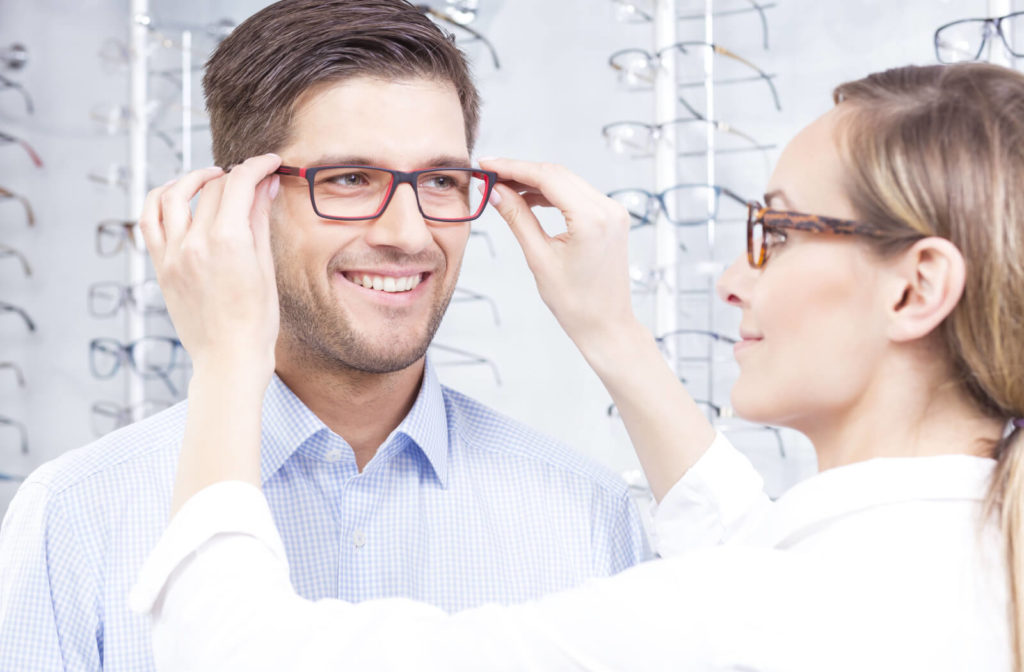A photochromic lens, also known as a transition lens, works by transitioning between a clear tint and darker tint in response to molecular changes in the lens material triggered by light. Transition lenses can be beneficial in protecting your eyes from the sun’s harmful UV rays without requiring a second pair of glasses or prescription sunglasses.
Transition lenses may not be right for everyone. Your eye doctor or optician can walk you through your lens options during your next eye exam. We can help you determine whether a photochromic lens could be beneficial based on your specific lifestyle and vision needs, or if a dedicated pair of prescription sunglasses may work better for you.
What Are Transition Lenses?
When most people think of a color-changing lens, the term “transition lens” often comes to mind. You might be interested to know that Transitions are just one branded version of photochromic lenses—lenses that adjust their tint in response to light—much the same as Kleenex is the branded version and household name of nasal tissues.
That being said, the terms transition lens and photochromic lens can typically be used interchangeably to describe a lens that transitions from clear to tinted based on the lighting in your environment.
How Do Transition Lenses Work?
Photochromic lenses work by the activation of photosensitive cells embedded inside the lens. When there’s no UV light around, these cells aren’t activated, so the lenses remain clear. But when they’re exposed to UV light, like when you’re outdoors, these cells spring into action and cause the lenses to darken.
How Do Photochromic Lenses Differ from Regular Lenses?
Photochromic lenses and regular prescription lenses are like two sides of the same coin. They can both correct your vision, but transition lenses can go that extra mile by darkening when exposed to UV radiation, offering extra protection against the harmful effects of UV radiation and visual clarity when in bright sunlight.
It’s important to know that the tint of your lenses is not what provides UV protection but rather the design and coatings used for your lenses. Clear prescription lenses can also have a UV coating that helps protect your eyes from the sun’s rays. Likewise, photochromic lenses can also protect your eyes when they’re clear.
Are Photochromic Lenses Worth It?
Photochromic lenses have advantages and disadvantages that are worth considering together. Whether or not photochromic lenses are worth choosing is a personal question that can depend on your lifestyle and vision needs.
Advantages of Photochromic Lenses
Some advantages of photochromic lenses include:
- Convenience: Because photochromic lenses automatically change between clear and tinted, there’s often no need to have a dedicated pair of sunglasses. So, the convenience factor of not needing a pair of prescription sunglasses can be a major benefit.
- Potential cost savings: You may save money by choosing a single pair of photochromic lenses as opposed to buying a separate pair of prescription sunglasses, even if a high-quality transition lens for your eyeglasses costs a bit more.
- UV protection: UV protection can be a significant benefit of using a photochromic lens. Many of these types of lenses offer UV protection that may not come with other prescription lenses unless special coatings have been added.
Disadvantages of Photochromic Lenses
Some potential disadvantages of photochromic lenses include:
- The tint may be too dark or not dark enough: The level of tint can vary between brands of lenses. This is where a conversation with your eye doctor can be helpful. We can point you to the brand of photochromic lens that can be beneficial for your lifestyle.
- They can be affected by temperature: Transition lenses may not be ideal for you if you live in a cold climate and require lenses that change quickly because temperature can affect how quickly photochromic lenses react to UV rays.
Why Protect Your Eyes from the Sun?
Protecting our eyes from the sun isn’t simply about being able to see while it’s bright outside—although that is a legitimate reason as well. The ultraviolet (UV) radiation that the sun emits can damage our eyes and the sensitive areas around them. Unprotected exposure to UV radiation can contribute to several eye diseases and conditions ranging from cataracts to skin cancer to growths on the eye called pterygium.

Discuss Your Eyewear Options with Your Optometrist
We all have varying vision needs. Finding the right lenses for your needs is important for getting the most out of your glasses.
A photochromic lens may be great for someone who spends some time outside but not enough time to justify the cost of a second pair of prescription glasses. On the other hand, someone may have additional needs, such as impact-resistant outdoor wear or polarization, so a dedicated pair of sunglasses may be better.
Book an appointment at Dr. Henslick Vision Center today to get personalized advice for your eyewear choices. One of our experienced optometrists can offer you suggestions on lenses after examining your eyes and listening to your visual needs.




